Video review: Sony HXR-NX100 camcorder
Sony’s HXR-NX100 camcorder is a very low cost, HD-only, entry-level newgathering-style all-in-one device. t’s slightly bigger than a Canon XF200 but not by much and is lightweight and easy to carry around. A step up from consumer grade camcorders, this offers a full complement of manual controls along its body.
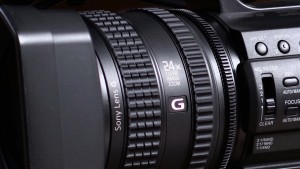
Three lens rings deal with focus, zoom and iris, each being easy to grab and turn via a textured finish. The lens offers 12 x optical zoom and 24x with Sony’s Clear Image enhancement which we’ll come back to.
The first sign of the low cost nature of this camcorder is the lens cap which is detachable and therefore loseable rather than a flip-open hood as found on Sony’s more expensive camcorders.
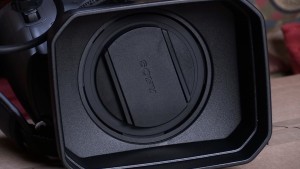
As mentioned, all the main controls are on the left side including customisable buttons, auto and manual toggles and audio controls. The top row contains three assignable buttons; the other two are on the other side, on the handgrip behind the zoom rocker. A three-position ND filter is included for shooting in bright light so there’s no need to screw on filters to the lens – just flick the switch to what you want.
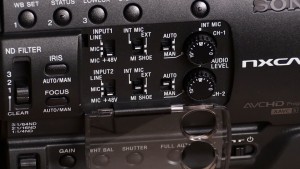
Whilst you don’t get the usual three-position toggles for immediate access to gain and white balance presets, you can change them by first pressing their button and then clicking this button up or down to change the value. It’s more flexible than a preset but more time consuming.
Two channel audio is set from a typical selection of inputs and gain knobs hidden behind a transparent flap. A quick-to-open mic holder is provided on the top right of the camcorder. Below that you’ve got the two XLR balanced inputs covered by a rubber flap to keep muck out. No shotgun microphone is included with the camcorder by default but again as usual there is a basic built-in mic at the front of the top handle which would be OK for gathering generic atmos sounds provided you cover it with windjammer fur.
Alternatively, Sony’s “MI” hot shoe on top gives the option of connecting certain types of mic such as radiomics directly into the camcorder without needing cables.
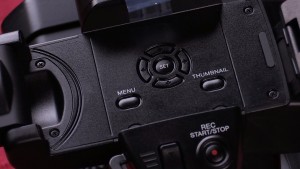
Another sign of cost cutting comes underneath the flip-out LCD screen, the paucity of controls meaning you do a lot of pushing and clicking on the ones that are there, either to watch footage back or to change options in the menus. Not much on the top handle either – yes a record button and zoom toggle but no zoom speed control and no mounting holes for accessories. This is a pared-back camcorder with just the essentials.
The back has the battery compartment – the classic NP-F type of cells in use here. Two SDXC card slots provide for dual and relay recording. Don’t be fooled by the BNC connector; it’s not HD-SDI but composite, with stereo analogue audio on the phono jacks below. HDMI is also there and USB.
Finally, a 3.5mm headphone jack is sensibly placed and a LANC compatible remote jack is a welcome sight. Over on the handgrip you just get the record button and a charging LED.
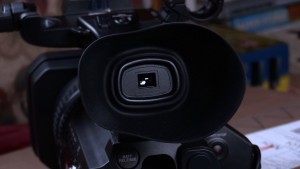
By far the worst feature is the viewfinder. It’s possible to get focus and exposure with it but it’s a nasty display that flickers the colours as you look – and it won’t come on if the LCD is on, and vice versa. Really inconvenient in live event shooting where you often flick between screen and viewfinder according to the conditions.
Luckily, the screen isn’t so bad, a very traditional Sony look in the way it’s laid out; there’s focus peaking in various colours and zebra bars and a histogram to help with exposure.
But what do the 50 megabit XAVCS images actually look like?
Well the video above includes a selection, some handheld, some on the tripod, at various f-stops and ND filter combinations, all at 1/50th shutter and mostly zero gain except where noted.
The zoom has a 12x optical range but because there are so many pixels on the sensor, Sony can crop in to give a 24x effective range without pixel interpolation. This they call Clear Image Zoom and if we’re honest, we’re not fans. You can see when it’s turned on and the zoom goes into that 12-24 range we think. But it’s better than nothing perhaps.
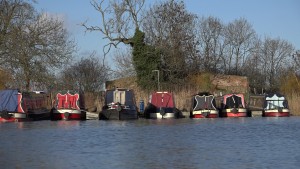
Three stabilisation modes are provided: off, standard and active the latter of which crops in the image then using the spare pixels to steady the shot and it works well as these tests show. Not, it’s not a steadycam but what do you expect?
Just before we get to low light testing, have a look at the sample of a dark but properly exposed image for any noise. As YouTube compresses everything so heavily we’ve blown up a section of the image to help. We think it’s reasonably well contained; we’ve certainly seen a lot worse with our XF200 which we’ll come to in a moment.
Our low light test scene is lit only by the 2 Watt LED bulb plus an identical one directly opposite and out of shot, and another just behind the camera.
At 15dB gain, the scene is roughly as our eyes would see it and given how much we’re boosting the signal, we’re impressed. When we tested Sony’s PXW-X70 it had a similarly impressive signal to noise performance under gain, and the NX100 has a similar if not identical sensor. Yes, you can see the noise – but this is 30dB of gain, it’s very good going in our opinion.
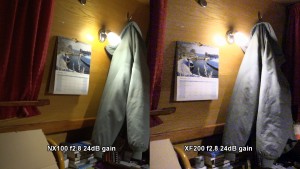
It’s more impressive when you contrast with how badly Canon’s XF200 does, which would be a competitor camcorder at this price range. Set identically as regards iris and gain, the Canon is hugely noisy – and its auto white balance is doing very badly compared to the Sony; the coat in the picture is actually green, not grey. And the noise in the Canon image is shocking.
That said, the Canon’s lens does open wider, so we tried that; matching the brightness gives f1.8 on the Canon at minus 3 dB compared to f2.8 and 9dB on the Sony. So you’d think the Canon actually has the edge.
But as you turn things up, you can see the Canon’s image is terrible compared to the Sony despite its wider iris and lower gain. We don’t know what magic Sony does in its camcorders to mask noise but the Canon gets a sound thrashing in noise and colour.
In conclusion then, Sony’s NX100 has very decent HD pictures. It’s got reasonable stabilisation for handheld work and all the necessary manual controls which are easy to use, plus there’s inbuilt balanced audio. The downsides are that dreadful viewfinder which won’t stay on if the screen’s on, and it is a “no frills” camcorder, it’s kind of what you see is what you get. But the price is astonishingly low, pitching it only just above where the top ends of high street holiday camcorders ends.
And no, it doesn’t shoot 4K nor is there any plan for it to do so. But if you’re in education, a video journalist, a web producer or an in house corporate marketing department which wants to put some video online without the aggro of changing lenses, messing about with split audio, dealing with shallow depth of field and so on, this is practically a disposable tool for the price that you can pick up and shoot with in any scenario immediately and get decent results. So if you’re not bothered by 4K but you want a good, controllable HD camcorder at a very sensible price, this is worth a look.
Hello,
I really enjoy your reviews. I was planing to buy this NX 100, but the viewfinder issue is making me now very uncertain.
However, after the CES2016 I have the impression, that there is nothing new to be expected, neither from Sony, nor from Canon, nor from Panasonic regarding the classical Camcorder type.
What would be your recommendation? If I can afford the more expensive Canon 200, is the NX100 still the better choice despite the horrible viewfinder?
Is the viewfinder of the Canon significantly better? I do not care about 4K and I do not need any “frills”, I’m not scared by the switching between the viewfinder and display, though I agree, that it is a very bad solution. But I do prefer to use the viewfinder outside, while frequently filming in sunny countries like Italy or Greece. This camcorder will be my step to HD, after using many many years the legendary DCR VX 1000.
I do not use it for business, just like to do nice films for me and my friends, but I need the manual control elements.
Thank you very much in Advance.
That’s a very difficult question. I really like my XF200 and the viewfinder is fine. But it does have a rather noisy image, even in good light (it’s pretty much the camcorder’s only failing). The Sony has a much less noisy image and that 1″ sensor means you’ll get shallow depth of field slightly more easily if you want. But the Sony feels a bit more entry level compared to the features of the Canon (eg proper waveform monitor, rotating handgrip). For “nice films for friends” I think the Sony is fine, you just have to live with the viewfinder.
I can’t make the iris on this camera completely shut down – no way to record black. Any trick?
As I recall, I found the same thing. You’ll just have to put the lens cap on :-)
You have produced two excellent reviews on the Sony HXR NX100 and the JVC GY-HM170.
Even though I am a strong user of the JVC cameras and the ease of working with the .mov media on Final Cut Pro X,you got my attention with the NX100. Its low light performance as you demonstrated was very well done. Now that FCP has worked out the kinks with importing the XAVCS media I feel it is a format I can work with.
With that being said which camera would you select as your personal choice.
What are you thoughts?
Well in some ways it depends what you need; the JVC shoots 4K, the Sony does not (though they have just announced a version that does but it’s a LOT more expensive than the HD one).
I’ve always used Sony gear so I like it and am used to it. The JVC has more features but the focusing issue was annoying. I think it really does come down to personal preference. The JVC is now available at a very decent price (the HM170 version, now including the XLR handle in some deals, I believe)
hello, Thanks for the review, I wonder if you would have a recommendation for a video camera to use at air displays. I don’t want to do anything fancy with the final recording i.e save to disc and watch on the telly. But i want good clear true colour good in changeable light. And it must have a good view finder as i find lcd’s next to useless in bright light or tracking fast jets. any comments would be appreciated.
Thanks.
David.
Depends on your budget, whether you’re going to use a tripod or go handheld and how expert you are or if you want to leave it in auto.
What’s a problem in view finder of sony hxr nx100
I talk about the problems with it in the review.
Hi friends! I’m looking for a new camcorder.
I’ve been reading about several brands and models and I still can’t decide.
My first choice was the Panasonic AG-AC90, then I went to the Sony HXR-NX5R and due to its price (USD 3400 here in Argentina) I went to the Sony HXR-NX100 (USD 2600). Although, I could afford the HXR-NX5R I believe it’s a big “jump”.
I would be “jumping” from my JVC Everio GZ-HM30BU, a 2012 costumer camcorder, to a professional one.
Must say customer reviews are making me mad. For example, I was reading about the NX100 and I was almost convinced to buy it, but then I read some bad reviews about it, customers complaining about errors after some month of using or after a year. And now I think I’m at the start again.
What I’m looking is an “entry-level” camcorder. Can you suggest me some brands and models?
What can you say about the models I mentioned or the Sony NX100 error?
My budget: between USD 1500 and USD 2800.
Like I explain before, I could afford a bit more, but I believe it doesn’t worth it as it would be my first professional or semi-pro camcorder.
Thanks!
The NX5R, despite being rather more expensive, is somewhat of an older camcorder than the NX100 so I’m unsure if they’re really directly comparable. I’m not aware of errors on the NX100 but if they occur within a year, Sony’s professional warranty should cover it (in the UK that’s a next-day replacement if I recall correctly).
You might also look at Panasonic’s AG-UX90 (the AC90 is really old now and although quite good for its time, is really rather outdated) or, if you can stretch to it, the HC-X1. Neither of those Panasonics are particularly great in dim light though, so that may affect your choice. If you are OK with a smaller size semi-pro camcorder then Sony’s new HXR-NX80 could be of interest.
Canon doesn’t really have much in that price range that’s up to date at present.
First of all, thanks for replying.
I’ve been watching videos about the HXR-NX80. Seems to have a nice image quality. Although I’m OK with smaller size semi-pro camcorders, I saw it doesn’t have the 3 rings like the NX100 (focus, zoom and iris). Like the X70, it has one ring which you can manage by using a buttom.
Didn’t watch anything about the AG-UX90 yet, but like you said, the lack of good image in low light may affect my choice. I don’t have the prices from my local seller yet, but doing a search on EBay the HC-X1 it’s a bit out of what I consider a logical budget, considering I’m looking for an “entry level” camcorder.
As far as I could see, Sony and Panasonic seem to be the only brands which have “entry level” camcorders, am I right?
Thanks for replying!
I took look at Panasonic AG-UX90, but, the poor image in low light may affect my choice. I did a search on EBay and the HC-X1 price seems to be a bit out of what I believe is a reasonable budget, in my case. I’m looking for an entry-level camcorder and to spend more than USD 2600-2800 I think it doesn’t worth.
My idea is to do some local news coverage, an amateur coverage. Some public events and stuff like these. I won’t be doing this everyday, it’s not my job. I won’t do weddings.
But, I got a budget and I want something a bit more professional than a common consumer camcorder.
I believe, at least in my case, this would be a camcorder for the rest of my life. I’m not a professional videomaker or journalist but I want something a step beyond the consumer camcorders.
This is an expensive product, at least in my country, and I don’t think I would have the chance to buy something else like this in the future, either ’cause I didn’t like the image or I don’t feel comfortable the rings location or the lack of three rings or something else.
I have to use very well my budget.
I’m not looking for a 4K camcorder. I want a Full HD camcorder in order to do a quick 5-10 minute videos edition and upload it to YouTube.
The XLR inputs are important. It would be a big change from my ambient sound I get with my actual camcorder (no XLR inputs). I will be able to use them to do some reportage, with a clear direct sound.
By the way, where can a get the release date?, because what I found doesn’t match with what you said. I mean, take a look a at this web page (https://kagoo.co.uk/camcorders/compare/sony-hxr-nx100-vs-sony-hxr-nx5r). It says NX100 is 2 years old while the NX5R is 17 month old.
As for the error customer reviews, here is where I read them: https://www.bhphotovideo.com/c/product/1156385-REG/sony_hxr_nx100.html
Some complained about the focusing, others about a stabilization system failure (Error code: E:62:10)
As for smaller size semi-pro camcorder, I’m OK with them. I’ve been watching some HXR-NX80 test videos and seems to has a nice image quality. I notice it doesn’t have 3 rings. it only has 1 ring and you have to select what you want to manage (focus or zoom) by using a buttom and the iris by using another buttom. Like the old X70.
Sometimes bigger equipment seems to have a more professional look. But the NX80 seems to be a nice camcorder.
I’m not saying the NX100 or NXR5 are “out of game”, but in case I decide for the NX80, which would be the best choice: HXR NX80 or PXW-Z90? I mean, seems to be the same but they are not. So, which model would be the best choice: the XDCAM or the NXCAM?
One thing I don’t like of them is the touch LCD screen.
Thanks!
The NX80 and Z90 are almost identical but the Z90 has a 3G-SDI output (which you might use if you were connecting to a live broadcast infrastructure such as a satellite truck) and it offers a slightly different codec XAVC-L instead of the NX80’s XAVC-S. For your use, there would probably be little practical difference and therefore no benefit to paying the extra for the Z90.
I have double checked on Sony.co.uk and the NX5R was indeed launched in Sept 2016; I was remembering a prior version of it called the NX5 which is now discontinued.
Hi! Despite having three 1/2.8 type sensor, does the NX5R have good image quality in low light? Does the sensor size matters in this kind of professional camcorders? I mean, here this camcorder costs the same as the NX80, which has one 1″ sensor. So, I believe both has a good quality image in low, isn’t it?
I don’t know why they cost almost the same. When I search them in Sony Store (https://pro.sony.com/bbsc/ssr/cat-broadcastcameras/cat-nxcam/) there’s a difference of USD 950.
I know this is a personal desicion based on my needs, budget and the use I’m going to give to the camcorder, but, as I’m new in this topic I would like to know what you would chose if you have to chose between these to models.
Thanks!
PD: Another offer they made me is the X70 for USD 2800. Should I consider other brands, like JVC?
I was not a huge fan of the JVC camcorder (I forget its model name) at this price, it had too many limitations. I cannot comment on the NX5R’s low-light capabilities as I have not tested it. The sensor size does always matter but if I recall correctly, the NX5R has three chips versus the NX80’s 1 (the latter is becoming much more common, mostly in cameras that shoot 4K). But they have different form factors and ergonomics and facilities and really that would inform your decision. For example, if you need only HD and must have lots of manual controls then the NX5R is the only one of those two that fits. If you need a compact body with 4K then it would have to be the NX80.
Hello I just purchased a Sony NX100 for my church my problem is I need to know if this camcorder can send video out from hdmi and bnc at the same time? Why I ask is because I use the hdmi output to a projector at church, now I want to send the video to 2 tv from the bnc port is it possible to send out the video from hdmi and bnc same time?
I’m not sure, I think you will need to consult the manual.